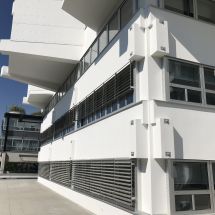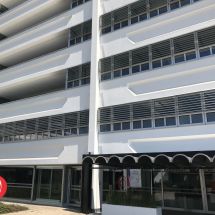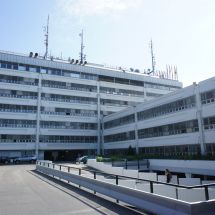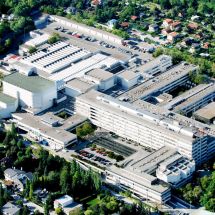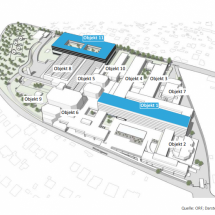ORF Center Vienna
Renovation Object 1 - An Exciting Challenge
The ORF Center on Küniglberg in Vienna was constructed according to the plans of Roland Rainer starting in 1968 and gradually put into operation between 1972 and 1975. In 2007, significant parts of the area were placed under historical protection. In 2014, the ORF Foundation Council decided to comprehensively renovate the ORF Center and relocate additional Vienna-based ORF departments to the new media location. Years of planning and feasibility studies ultimately led to the Foundation Council's decision to consolidate the Vienna sites at the existing Küniglberg location in Vienna-Hietzing – through renovation of the existing structure and an extension through a new building. The "Concrete Fortress on Küniglberg," as architect Roland Rainer referred to the television center, is a protected historical landmark. For ORF, bringing together television, radio, and online operations at Küniglberg is not only a logical consequence of changing media consumption habits, tightened conditions, and channel convergence but also results in significant cost savings.
Object 1 is the main building of the ORF media location on Küniglberg. Despite the challenging requirements imposed by historical protection, it achieved 971 out of 1000 possible points and received the klimaaktiv Gold certification.
Vasko+Partner, in collaboration with architects Jabornegg & Pálffy, was entrusted as the general planner for the renovation. The scope of work included project preparation, planning, execution preparation, architecture, structural engineering, technical building equipment, building physics, and fire protection planning. This covered all specialized areas (foundation, development, shell, technology, interior finishing, furnishings, outdoor facilities, and planning services, etc.). The planning focused particularly on innovation, usage optimization, life cycle cost optimization, operation cost optimization, and consideration of historical protection.
Thermally Renovated
The thermal envelope's quality was significantly improved: New high-quality windows with sun protection, the application of insulation layers, and the renovation of aging building connections contribute significantly to reducing energy demand. A special challenge was the protected historical façade: The new thermal insulation composite system (approximately five centimeters) had to be structured to correspond to the historical structure.
The building is connected to the urban CHP district heating network with a high proportion of renewable energy (waste heat) and has a central cooling system. All areas are now supplied with fresh air through a ventilation system with heat recovery. The thermal renovation has reduced the building's transmission heat demand and heating costs by approximately half, and the ventilation heat demand has been reduced by 60 percent. In the lighting technology area, all lighting systems were completely renewed with LED-based systems, including presence control and daylight-based optimization. Depending on user behavior, savings of around 30 to 40 percent are expected. Comprehensive control and monitoring systems for building technology and energy consumption were implemented in the central building management system.
| Project owner | Österreichischer Rundfunk, 1136 Wien |
| Architecture | Bestand: Roland Rainer, Sanierung: Jabornegg & Pálffy |
| Full design team | Arge Vasko+Partner Ingenieure und Jabornegg & Pálffy Architekten |
